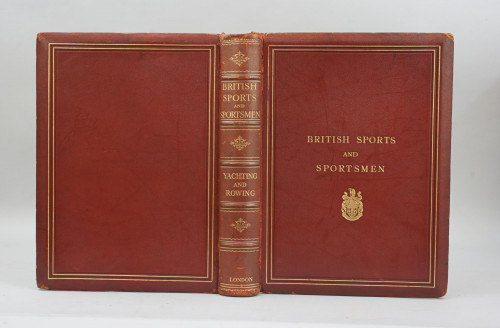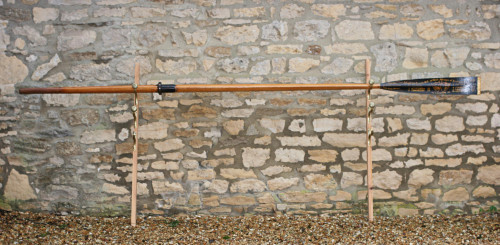- Home
- Rowing & Yachting
- St John's College, Oxford University, 1937 Torpid Presentation Rowing Oar
St John's College, Oxford University, 1937 Torpid Presentation Rowing Oar
St John's College, Oxford University, 1937 Torpid Presentation Rowing Oar
28213
Rowing Oar Blade, St John's College 1st Torpid 1937.
The full length oar is an original traditional St John's College (Oxford University) presentation rowing oar with gilt calligraphy and college insignia. The writing on the trophy blade is in good condition giving the names and weights of the crew and the colleges they 'Bumped'. The oar may have belonged to C.A. Harrison-Jones or G. Wheaton-Smith, as we have a second oar from 1939 that have both their names on as well.
The trophy blade reads:-
St John's College 1st Torpid 1937
five bumps
Bow...H. Picker.....11st, 1lbs
2...M.C. King.....11..3
3...W.G. Hurlow.....11..1
4...M.H. Prescott.....13..3
5...O.F. Charleton.....11st, 11lbs
6...C.A. Harrison-Jones.....12..10
7...J.F. Harward.....10..8
Str..G. Wheaton-Smith.....11..10
Cox...R.H. Ogden.....9st, 5lbs
Bumped - Merton, Keble, Corpus Christi, Oriel, and Balliol.
St John's College Boat Club (SJCBC) is a rowing club, part of the University of Oxford. The club was founded in 1863, located on the River Thames at Oxford, with the Club colours being a white shield with blue cross upon a navy blue background.
Both Oxford and Cambridge Universities host two university bumps races yearly, each lasting several days. The races are for eights (i.e. eight rowers and a cox), each representing one of the university's various colleges. One of the races is held in early spring and the other in early summer, in Oxford they are called 'Torpids' in the spring and 'Eights' in the summer, in Cambridge these are called 'Lent Bumps' and 'May Bumps'. The leading crews of the Lent Bumps go on to race the leading Oxford Torpids crews at the Henley Boat Races around Easter.
The first attested bumps race took place in Oxford in 1815 and was between two eights from Brasenose College and Jesus College. Twelve years later Lent Bumps racing commenced at Cambridge University. As the Isis and Cam are long narrow rivers, not ideal for normal side by side racing, Bumps racing evolved. The competing crews line up bow-to-stern in order, one behind the other with gaps of about 1½ boat lengths between them. The start of the race commences with the firing of a cannon, the idea to progress up their division by attempting to catch and Bump (touch) the boat in front whilst simultaneously trying not to be Bumped by the boat behind. The ultimate aim becoming top of the first division and "Head Of The River". When a bump has taken place both of the crews involved in the Bump pull over to the river bank and take no further part in that race, allowing the rest of the division to pass. The only difference is in Torpids where the crew whose boat was Bumped has to continue racing (and is liable to be bumped again). It is possible to "over bump", if the 2 crews involved in the Bump have pulled over and the crew behind them manage to catch the boat that was in front of them, this is an "over bump".
As the oar is full length (12 foot) shipping can be quite expensive. We have came up with an ingenious way to cut the oar so as to make shipping cheaper, the oar can then be easily reassembled. One of the images shows different images of an oar that has been cut down. It is cut by the leather sleeve so the joint is less visible or obvious. The oar can then be bolted together to make the oar one solid piece.
Please do inquire about the different shipping options.
Dimensions:
1900-1949
1937
Pine
United Kingdom
The oar tip does have a slight chip on the top edge, calligraphy in good order.
Thank you for your enquiry.
We will get back to you soon.
Please create wishlist to add this item to
RELATED ITEMS









































